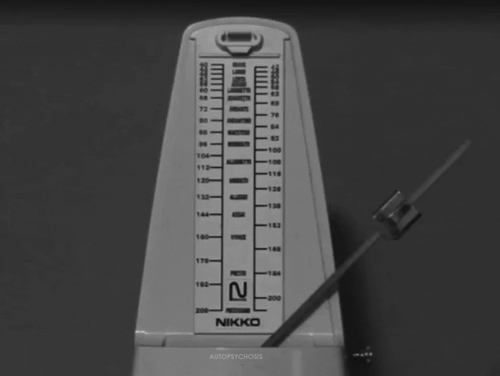Metronome
Ever hear of a metronome?
What a cool name! It sounds like it might be the name of a Transformer, or maybe a place where gladiatorial combat takes place, but metronomes are pretty cool in their own right.
Let me set the stage by traveling back to the time of Galileo, during the 16th century. Galileo was a true polymathic titan, not only interested in lots of cutting edge science, but also contributing to several fields in major ways.
Galileo observed the motion of astronomical bodies, and compared them to terrestrial objects falling here on Earth. This early hint that gravity was universal was contrary to the conventional wisdom that the celestial bodies followed different rules than things here on this planet. The further he went along with his studies, the more Galileo began to rock our understanding of the universe.
2000 years earlier, Aristotle had asserted that bigger things fell faster than smaller things. Galileo showed this wasn’t true, and noted that you could really see this clearly if you observed a pendulum. How hard you pushed and the length of the string were crucial to the outcome, but it didn’t seem to matter how heavy the object was.
Not only did he revolutionize our understanding of gravity other scientific fields of study, but he was also passionate about the arts.
In particular, Galileo enjoyed listening to music. Precision manufacturing in Italy had led to some incredibly accurate instruments to be made, and there were now large orchestras playing delightfully complex pieces, much to the appreciation of the intellectual elites of Florence during this time. Unfortunately, as the pieces got more and more complex, it became ever more challenging for all of the musicians to keep a common time.
Galileo had an idea: he could build a device that would keep a beat going, so musicians could listen to a recurring clicking sound. They’d know what sort of beat to follow, and everyone could follow this repetitive sound in order to stay in time together.
To solve this problem, Galileo went back to the well, so to speak, and revisited his pendulums. He knew that gravity ensured that the beat would be fairly consistent as the heavy weight swung back and forth, so he created a little pendulum that would measure someone’s pulse—you could sort of adjust the speed of the falling ball in order to get this to roughly sync up.
Galileo wanted to use something similar for musicians, but he never got to invent a working metronome, named centuries later after the Greek words for measure and regulate. These days, we have digital versions of these devices, but the mechanical pendulum-based systems are pretty much exactly what Galileo envisioned.
Now, I want to talk about something very curious that happens if you set several of these devices to clicking away on a table somewhere. You can set them all at different times and at different intensities, and then just walk away.
When you return a few minutes later, something that seems almost disturbing or supernatural has happened. All of the metronomes are now clicking in near-perfect unison, all clicking at the same time with each pendulum raise.
This is like one of those physics facts you hear and then think to yourself, no, I must have misunderstood something. This is like the observation problem or the relativity of simultaneity, but it really does happen.
This is called synchronization, and there is a reason behind it that makes perfect intuitive sense. When the metronomes start swinging, they’re all clicking at independent tempos. However, this cacophony of chaos is destined to live a short life.
Each metronome causes the table (or whatever surface it’s on) to vibrate just a tiny bit. This is the part that’s easy to see: vibrations surely rattle through the table and up into the other metronomes, kind of like an earthquake in Japan being felt in Washington.
What’s fascinating isn’t that they nudge one another—that’s pretty obvious! What’s interesting is that they’ll all be in sync within a few minutes.
If you can imagine those little vibrations acting a bit like tiny hands giving those pendulums a push each time they vibrate, you’re starting to get the idea. This has a lot to do with wavelengths canceling one another out or amplifying each other, and if you want to read more about how that works, I recommend this:
Those little nudging hands gradually do the work of pushing one pendulum very slightly faster if it’s going too slow, and slowing it down if it’s going too fast.
You can see how quickly this happens with the right setup:
Emergent synchronization isn’t unique to metronomes! You can see it all over the place in nature: fireflies will tend to flash in unison if given enough time, and there’s even a gigantic example of this you can see every night: the moon and its tidal lock with the Earth.
Even human neurons follow this principle, firing in unison whenever we see a face, for instance.
This sort of self-organization in nature is endlessly fascinating, and it’s surely a necessary component if you want to go from non-life to life. Where else might this principle apply?
Emergence provides the next rabbit hole for you today:
Emergence
The word emergence describes when something comes to light that wasn’t known before, like the Mind Flayer in Stranger Things:
And, I’ll leave you with this appropriately named song Metronome from the band Nomeansno (let me know if you like these guys!):







At one time, "Metronome" was the name of a well-regarded magazine on jazz music, which picked musicians of the year by instrument via reader polls, like athletes. However, over time it lost ground to its rival "Downbeat" in that product category.
Ever seen the Tacoma Narrows bridge falling down? wave amplification/synchronization can seriously mess you up!
https://www.youtube.com/watch?v=XggxeuFDaDU